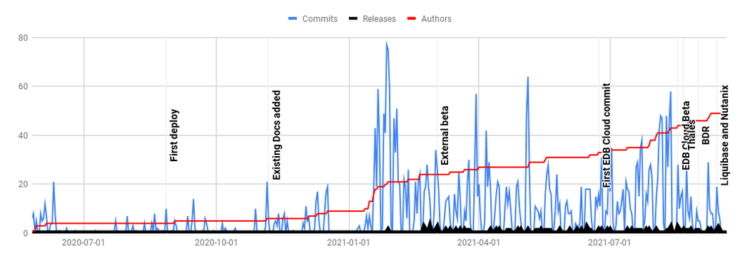Docs 2.0
An overnight success 15 months in the making
I wrote a short series for our internal blog at EDB last the fall. It’s an introduction to our updated documentation system.
- Everyone can contribute
- An overnight success 15 months in the making
- The beginning of a beautiful friendship
Over the course of a couple of weeks in August the documentation team added EDB Cloud and BDR plus three third-party integration guides (Liquibase, Nutanix and Thales) to Docs 2.0. Each came with its own challenges, but the new platform has proven itself to be flexible and capable of hosting a variety of content. More importantly, documentation kept pace with product development both for major releases and dozens of minor releases happening concurrently.
Many hands make hard work go faster
Since we use Git, it’s possible to construct a holistic history of development before the final product. We’re pretty proud of what we accomplished in August, but when you dig below the surface, it’s also a validation of a year and a half of effort:

This chart shows:
- Number of commits each day (blue). A commit represents work saved to the repository. It could be anything from a single character typo fix to adding an entire new section of content. The rate of commits increased greatly in 2021 because more people were working on the project in preparation for deploying Docs 2.0.
- Total number of authors who contributed up to that moment (red). It’s a running total of everyone who contributed so far. A contribution could be as small as fixing the wording of a sentence or as large as documenting a whole new product.
- Number of production releases on a day (black). Our first release was in January 2021 and by February we were in the habit of publishing two to three times a week. Each release rolls up all the work that has been committed to our development branch so far and makes those changes public. We have a robust review process to make sure we always have the best and most up-to-date content available to our customers.
- Key events are labeled on the date they occurred. For instance, you can see the first EDB Cloud commit happened in late June and that documentation was published in August. The 5 events I mentioned above (EDB Cloud, Thales, BDR, Liquibase and Nutanix) overlap on the chart as different teams completed documentation in parallel.
Of course, this chart doesn’t show the work that went into planning before the first commit to our GitHub repository. But it does show a small group of people who set up the framework in 2020 followed by a growing team of contributors refining the platform for the first half of 2021. Finally, starting this summer, the list of authors grew as more people from around the company made the push to release the EDB Cloud preview.
Speedy delivery of the documentation our customers need
Putting documentation on GitHub, an early decision I wrote about last time, enabled the developers, designers, writers and product managers to contribute to different branches of documentation simultaneously. Changes don’t have to wait for other, unrelated work, to be finished. Increasing the rate of change in documentation allows us to deliver better products to our customers more quickly.